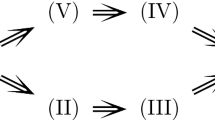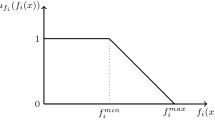Abstract
When solving a multiobjective programming problem by the weighted sum approach, weights represent the relative importance associated to the objectives. As these values are usually imprecise, it is important to analyze the sensitivity of the solution under possible deviations on the estimated values. In this sense, the tolerance approach provides a direct measure of how weights may vary simultaneously and independently from their estimated values while still retaining the same efficient solution.
This paper provides an explicit expression to the maximum tolerance on weights in a multiobjective linear fractional programming problem when all the denominators are equal. An application is also presented to illustrate how the results may help the decision maker to choose a most satisfactory solution in a production problem.
Similar content being viewed by others
References
Bereanu, B. (1953). Distribution problem and minimum-risk solutions in stochastic programming, in:Colloquium on Applications of Mathematics to Economics. A Prekope, Akademia Kiado (Budapest), 37–42.
Bradley, S.P. and S.C. Frey Jr. (1974), Fractional Programming with homogeneous functions,Operations Research 22, 350–357.
Bitran, G.R. and A.G. Novaes, (1974). Linear programming with a fractional objective function,Operations Research 21, 22–29.
Charnes, A. and W.W. Cooper, (1962), Programming with linear fractional functionals.Naval Research Logistics Quarterly 9, 181–185.
Derman, C., (1962), On sequential decisions and Markov chains.Management Science 9, 16–24.
Dutta, D.; J.R. Rao and R.N. Tiwari, (1992), Sensitivity analysis in fractional programming-the tolerance approach.International Journal of Systems Sciences 23, 5, 823–832.
Fox, B., (1966), Markov renewal programming by linear fractional programming,SIAM Journal of Applied Mathematics 14, 1418–1432.
Gilmore, P.C. and R.E. Gomory, (1961), A linear programming approach to the cutting stock problem,Operations Research 9, 849–859.
Hansen, P.; M. Labbé and R. Wendell, (1989), Sensitivity analysis in multiple objective linear programming: the tolerance approach,European Journal of Operational Research 38, 63–69.
Mármol, A.M. and J. Puerto, (1997), Special cases of the tolerance approach in multiobjective linear programming,European Journal of Operational Research 98, 3, 610–616.
Martos, B., (1964), Hyperbolic programing,Naval Research Logistics Quarterly 11, 135–155.
Meister, B. and W. Oetlli, (1967), On the capacity of a discrete constant channel,Information and Control 11, 341–351.
Ravi, N. and R. Wendell, (1989), The tolerance approach to sensitivity analysis of matrix coefficients in linear programming,Management Science 35, 9, 1106–1119.
Stancu-Minasian, I.M., (1980), Applications of the fractional programming,Economic computation and economic cybernetics studies and research 14, pp. 69–86.
Wendell, R.E., (1984), Using bounds on the data in linear programing: The tolerance approach to sensitivity analysis,Mathematical Programming 29, 304–322.
Wendell, R.E., (1985), The tolerance approach to sensitivity analysis in linear programming,Management Sciences 31, 5, 564–578.
Ziemba, W.T., C. Parkan and F.J. Brooks-Hill, (1974), Calculation of investments portfolios with risk free borrowing and leading,Management Science 21, 209–222.
Author information
Authors and Affiliations
Rights and permissions
About this article
Cite this article
Arévalo, M.T., Mármol, A.M. & Zapata, A. The tolerance approach in multiobjective linear fractional programming. Top 5, 241–252 (1997). https://doi.org/10.1007/BF02568552
Received:
Revised:
Issue Date:
DOI: https://doi.org/10.1007/BF02568552




